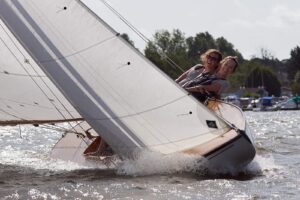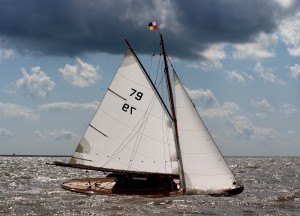The Broads One Design
Fleet & Club Page
While Royal Norfolk & Suffolk Yacht Club remains the parent Club and headquarters, owners generally race at either Wroxham or Oulton, but are enthusiastic and regular supporters of the June Regatta, Sea Week and the Southwold Race.

A Short History
By Mary and David Leech
The Broads One Design yacht is the oldest one design class racing at the Royal Norfolk & Suffolk Yacht Club. The yacht is 24’ 0” (7.3m) overall, 5’1” (1.55m) beam, 3’0” (0.9m) draft with a waterline length of 16’6” (4.9m) and a gaff rigged sail area of 262 sq.ft (24.0sq.m).
At the end of the nineteenth century yachts were being built by wealthy owners with paid crews and raced in mixed handicap races. If a yacht was not successful, she was scrapped. In these expensive circumstances, Linton Hope, a successful yacht designer of the time, was asked by a small group of Royal Norfolk & Suffolk Yacht Club members to produce a half decked one design that would be able to sail on the Broads as well as at sea.
The first five yachts were delivered by train on flatbed trucks from Burnham-on-Crouch where the majority of the timber yachts were built. The first race was held on Oulton Broad on Whit Monday, 1901. Thirty-one timber yachts were built over a period of 38 years. Twenty-seven still remain, including the first five built. The first twelve were carvel built in cedar and the remainder in mahogany.
The Broads One Design Class also became known as ‘Brown Boats’ due to their varnished hulls as opposed to other one design classes arriving on the Broads with their white painted softwood hulls.
During 1933 and 1934 a Bermudian rig was tried on Number 7, Kingfisher. However it was beaten by the original gaff rig yachts and the idea was dropped.
A unique feature of the class is that each yacht is allocated an individual racing flag. Initially the yachts were allocated a flag from the International Code of Signals flags, progressing to the numeral pennants (or “pendants”) and substitutes until all had been used. Currently house flags and others are allocated.
The first twelve yachts used their flags for identification during racing until 1911. Sail numbers were used in the 1912 sailing season for the first time, under protest from the class members, after the RN&SYC asked them to use numbers for better identification whilst at sea. Brown sail numbers were used first, changing to black for the 1927 season.

As the yachts proved so manageable, in 1908 a lady became an owner and several others followed. This became a problem for the RN&SYC, membership at that time being male only. It was not until after World War II that the RN&SYC relaxed its rules to allow female members.
In 1987 a glass fibre yacht was built, undergoing trials before being accepted. The introduction of the glass fibre yachts has rejuvenated the class. A further 55 glass fibre yachts have currently been built. The design lends itself well to fibreglass. Whilst the spoon bows and flat counter belonged to the period of its design, the short keel and shallow midships would not look out of place thirty years later.
Over the years, Linton Hope’s design has proved to be very safe and capable at sea, coping with the sometimes rough conditions experienced off Lowestoft while also racing successfully on the Broads against yachts designed specifically for Broads sailing.
November 2008
B.O.D Class Rules can be viewed HERE BOD RULES 2023
BOD Historic Register 1st Sept 2023
Boats for Sale
Please contact the fleet secretary for the most up to date list of boats for sale on secretary.bodfleet@gmail.com
BOD Events 2022
Please click 2023 EVENTS LIST (002)
